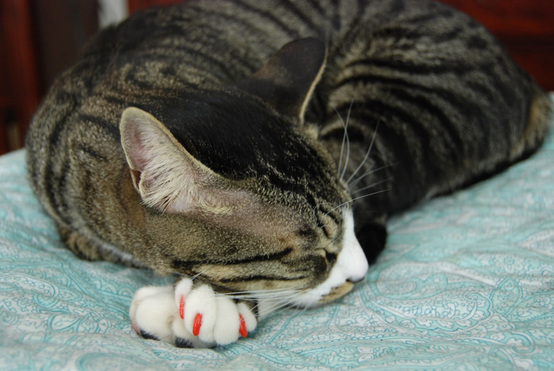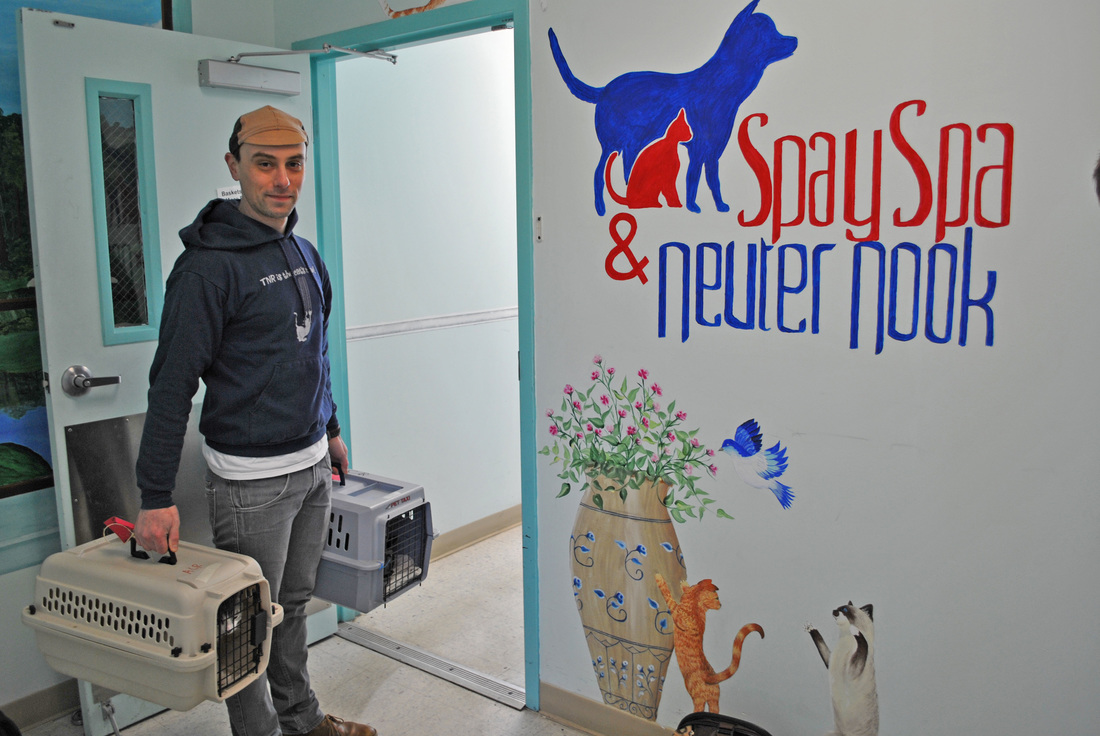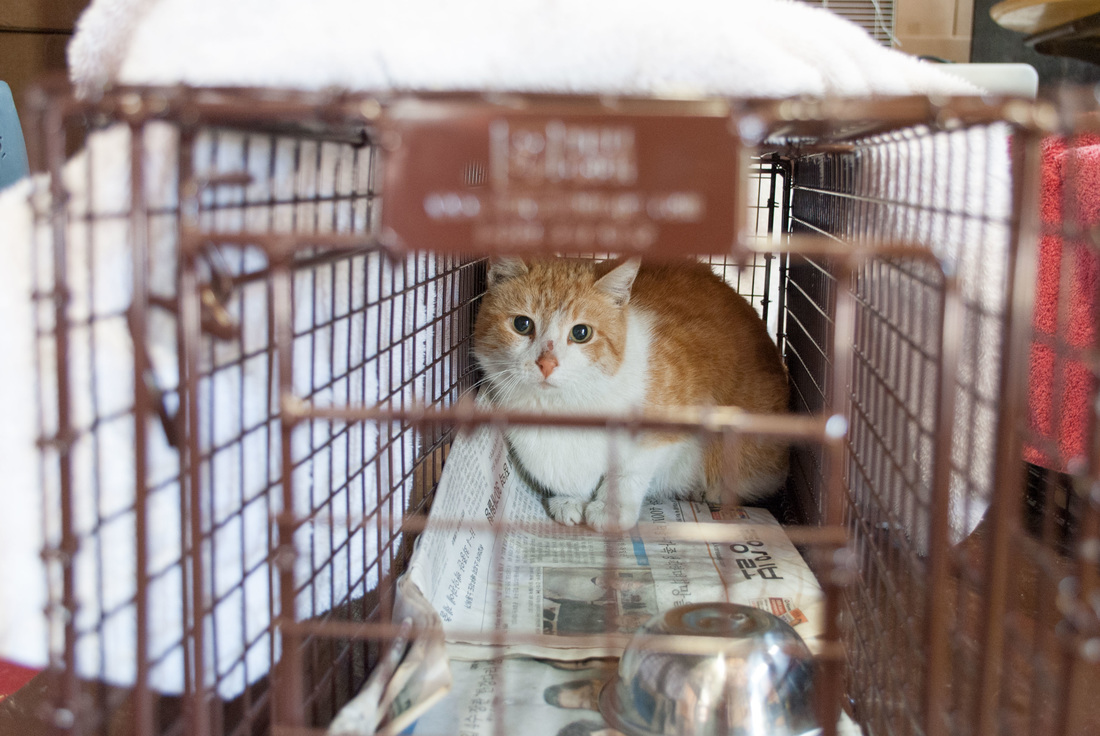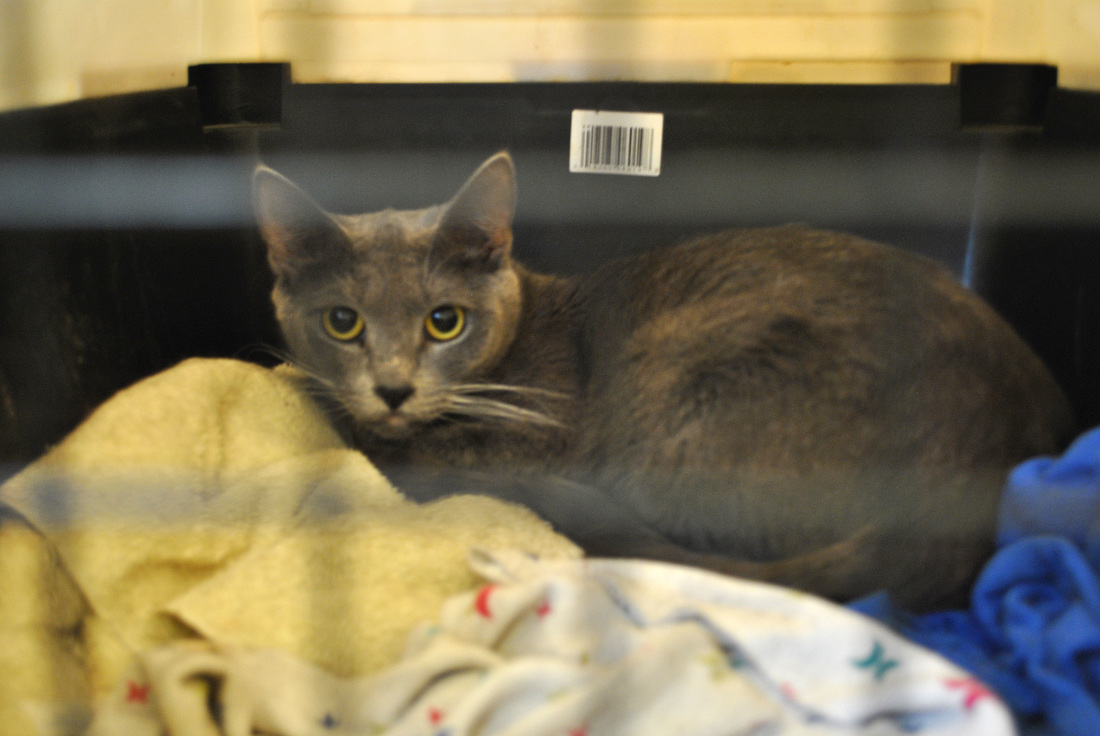|
When it comes to Tigger and his inappropriate scratching at the side of the couch or on the back of a favorite recliner, only in America does the word “declaw” come to mind. In most European countries, this procedure is considered “inhumane” and an “unnecessary mutilation” … in which it should be viewed. Declawing a cat is not a simple manicure, but the amputation of the last joint of a cat’s toe; in order to remove the claw, the bone must be cut. It’s equivalent to cutting off the first joint of a human finger. Ouch! This is a serious surgery with a painful recovery. And remember, the cat still has to walk on his paws, jump, and scratch in the litter box while experiencing this pain.
Claws are an important part of the cat’s design. Not only are they used for hunting, but also for exercise and marking territory. Cats scratch to help them exercise and stretch muscles, and to aid with grooming; scratching removes old nail sheaths. Cats also scratch to communicate their presence, by leaving both physical and scent marks. Cats have scent glands between their toes that leave pheromones behind to communicate with other animals. Additionally, cats use their claws to express emotion – when Morris scratches at your leg around dinner time with increased excitement – and for defense if threatened. Declawing a cat has no health benefits and comes with lots of potential and serious complications. Post-surgical problems:
Long-term, chronic conditions:
In addition to serious health problems, many cats who have been declawed suffer from psychological trauma that manifests as negative behavioral changes.
As anyone can see, declawing a cat is a drastic and cruel response to protecting furniture. The good news is there’s plenty of humane solutions to prevent Tigger from tearing up the couch.
Keep in mind, nail trimming and Soft Paws should only be used on indoor cats; if cats are permitted to go outside, they will need their claws for defense. In 2002, West Hollywood, California became the first U.S. city to ban declawing, with Los Angeles, San Francisco, Burbank, Santa Monica, Berkeley, Beverly Hills and Culver City all following suit in making declawing illegal. Later in 2012, California became the first state prohibiting landlords from requiring tenants to declaw or devocalize their animals, with Rhode Island following suit in 2014. And in January of 2015, a law was introduced that would make New York the first state to ban declawing; the bill is awaiting a committee hearing. For more information on declaw legislation visit (ThePawProject.org). Photo Credits: SoftPawsWiki photo: myllissa from Seoul, S. Korea (Red Nails Uploaded by Caspian blue) [CC BY-SA 2.0 (http://creativecommons.org/licenses/by-sa/2.0)], via Wikimedia Commons DeclawWiki photo: Turn685 (Own work Turn685) [CC BY 3.0 (http://creativecommons.org/licenses/by/3.0)], via Wikimedia Commons
3 Comments
Each year 2.4 million healthy and adoptable animals are euthanized in shelters. That means that about every 13 seconds, an animal who would have been a loving and loyal companion loses her life, often because the resources needed to care for her and find her a home simply aren’t available. On the first Tuesday of each month, Alley Cat Rescue takes the issue of pet overpopulation head-on by holding our Cheap Fix Cat Clinic. By offering low-cost services for community and pet cats, we reduce the number of adoptable kittens and cats needlessly killed in overcrowded shelters, as well as the number of cats living outdoors. Coming to the clinic is an easy process for people and cats alike. Clients begin by requesting an appointment online, then we follow up to confirm and provide clear instructions on how to prepare cats for spay/neuter surgery. On the morning of the clinic, clients drop off cats in traps or carriers, complete a couple simple forms, and are given an estimated time for pick-up. Once all the cats are checked in and traps and carriers are clearly labeled, Alley Cat Rescue staff and volunteers safely transport them to our partner clinic. Later in the day when surgery is finished and the cats have recovered enough to travel, we transport them back to our office for pick-up that evening, or hold them overnight when necessary. Clients also receive required vaccination documents and instructions for post-surgery care.  For community cat colony caretakers, finding affordable spay/neuter and vaccination services is crucial. Costs add up quickly when a caretaker finds a number of cats in a colony, sometimes ten or more at once, who are in need of veterinary services. Cost becomes even more important when you consider that caretakers are usually spending their own limited personal funds on a project that benefits the whole community. For this reason, we offer community cats spay/neuter surgery, vaccination, and ear-tipping for only $20, a fraction of what the same services would cost at a private veterinary practice. We also have humane traps to loan, which helps caretakers keep equipment and supply costs down. Pet cats are also welcome at the Cheap Fix Cat Clinic! A pet cat may not be spayed/neutered because a person plans to keep him or her indoors and doesn’t think it necessary. Someone may have found a kitten and brought her in from outside, and is solely focused on providing food and purchasing other essential items. Some also believe that kittens are too young to be sterilized or that it is healthier for a female cat to have a litter before being spayed. The truth is that kittens can be safely spayed or neutered once they reach two pounds in weight (around 8 weeks of age), and there is no health benefit to allowing female cats to have a litter before being spayed. We wholeheartedly encourage pet adoption, and to support those who’ve decided to add a furry member to their family, we offer spay/neuter surgery and vaccination for just $50. ACR Since launching the Cheap Fix Cat Clinic only two months ago, Alley Cat Rescue has provided these important services for nearly 50 cats in our community, and we are eager to help more! Having your cat spayed eliminates many medical and behavioral problems. In fact neutering a cat, male or female, adds years to their lives. It is one of the best things one can do not only to spare cats from death in an animal shelter, and bring down the euthanasia numbers, but it will increase the quality of your cat’s life and enable the cat to live longer. Over the last 20 years ACR has been spaying and neutering cats in the Washington DC Metro area. Over the years around 35,000 cats have been sterilized by ACR. Please consider making a tax-deductible donation today so that we can continue to offer these life-saving services and reach more cats in need.
Texas veterinarian Kristen Lindsey made national headlines last year after posting a picture to Facebook showing her holding up a cat shot through the head with an arrow. In the post, she bragged of the incident being her first bow kill and wrote, “The only good feral tomcat is one with an arrow through it’s head. Vet of the year award…gladly accepted.”
Last week Lindsey’s case went before the Texas State Office of Administrative hearings. The Texas Board of Veterinary Medical Examiners is seeking to revoke Lindsey’s license to practice veterinary medicine, arguing in part that the cat in question was an owned cat named Tiger and not a feral tomcat, and that no matter the cat’s identity, Lindsey violated her professional oath by killing the cat in a cruel and inhumane manner. Lindsey and her attorney argued that she was justified in killing the cat, that the arrow to the head of the cat resulted in instantaneous and painless death, and that killing what she believed to be a feral cat was in line with her oath because feral cats pose risks to the public and other animals. Lindsey and another witness who testified on her behalf, livestock owner Preston Northrup, also made statements to the effect that killing feral cats is widespread and common in rural areas of Texas. This case is disturbing for the manner in which the cat was killed and because the killer was a vet, a person who we assume has compassion and empathy for all animals and not only the companions who live in our homes. But we believe there is a broader issue at work here, and that is the mindset toward feral cats that Lindsey and Northrup described, which devalues feral cats simply because of who they are and where they live. They believe that every feral cat is dangerous, sickly, and unwanted. It is this immoral culture of killing that must be changed. As advocates for all cats, it is our role and responsibility to educate and provide resources to the public, the veterinary field, and policy makers, so they may come to understand that feral cats are the same species as our beloved companion cats, just living in a different environment and with a different view of humans. We must show people who feral cats truly are: intelligent, dynamic, and beautiful animals, so similar to our beloved companions and just as deserving of our respect and compassion. We must also continue to push for humane and effective management policies, like Trap-Neuter-Return, while showing trap-and-kill or shoot-to-kill methods for what they are; cruel and ineffective. Finally, we must never stop talking about our moral obligation to treat all animal lives, including all nine of every feral cat, as inherently valuable and deserving of compassion. We’re confident that the system in place will work and that Kristen Lindsey’s vet license will be revoked. In the meantime we’ll keep putting our comprehensive Guide to Managing Community Cats in the hands of as many mayors, councils, animal control officers, and compassionate citizens as we can. We’ll continue to grow our Alliance for Cat Protection program, which educates shelters and rescues across the country through hands-on workshops and training. And we’ll continue working hard to reduce the number of free-roaming cats outdoors through our monthly Cheap Fix Cat Clinic, which provides low-cost spay/neuter services for companion and feral cats, and the annual May Spay Challenge that gets new vets around the country involved with helping community cats every year. Our work for feral cats would not be possible without your support! Please make a tax-deductible contribution today so we may continue to provide these life-saving programs. Today cats are living longer than ever before, thanks to improved nutrition, advances in veterinary medicine and an increase in an indoor lifestyle. It’s no surprise to caretakers that cats are easily living into their teens and twenties. And yes some conditions are more common among senior cats, but not all cats experience the effects of aging and some show no changes at all. Just as humans age and we start the process of health screenings to check for particular conditions, it is important to schedule regular checkups for senior cats.
Vets recommend that cats around 7 or 8 years of age have a senior blood panel ran, which also includes a urinalysis, to check for certain conditions like diabetes, kidney disease, and hyperthyroidism. If your cat’s blood work does start to indicate any of these conditions, it is best to find them early so proper measures can be taken to address the issue, rather than finding such a condition in an advanced stage. Dental health is another concern for aging cats. Healthy teeth and gums are very important in maintaining the overall health of your cat. Infection in the mouth enters directly into the bloodstream and spreads throughout the body, so regularly scheduled teeth cleanings are vital. It’s also important to note that most cats tend to become less active, sleep more, and gain or lose weight as they age; however, these health and behavioral changes could indicate a serious underlying condition and should be mentioned to your vet and not simply chalked up to the natural aging process. Along with ensuring your cat has a healthy blood and urine report, it’s also important to speak to with a vet about your cat’s diet, so she is receiving the appropriate nutrition, coupled with plenty of water to help any kidney issues. And make sure your cat has easy access to her food and water bowls, as well as the litter box. Older cats can experience stiffening of the joints, arthritis, and incontinence, so make sure they can easily climb into the litter box – use boxes with low sides – and it’s a good idea to place a litter box on each floor of the house. Stiff joints and arthritis can make accessing favorite windowsills, chairs, or other sleeping spots difficult for older cats, so make sure to add ramps and pet stairs covered with carpet to provide secure footing and to prevent slips or falls. As your cat ages, here are a few other things to take into consideration:
For more detailed information on caring for elderly cats, including common health conditions and tips on creating a safer home for senior cats, click here. |
Details
AuthorAlley Cat Rescue is leading in the way in promoting humane and compassionate care for ALL cats. Archives
June 2024
Categories
All
|









 RSS Feed
RSS Feed